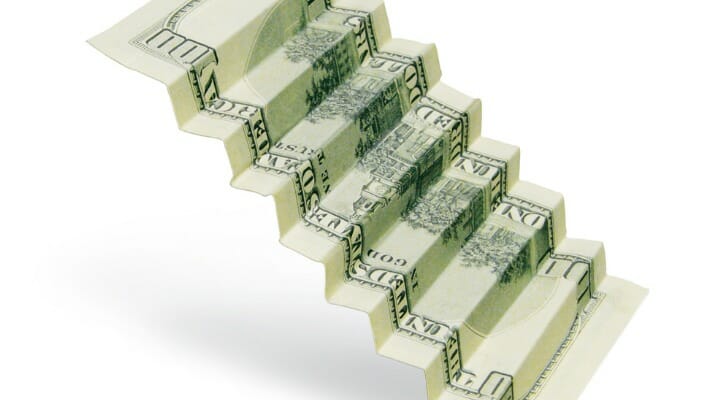One strategy that has gained popularity among savvy savers is the use of a CD ladder. This approach involves investing in a series of certificates of deposit (CDs) with staggered maturity dates, allowing for both liquidity and the potential for higher returns. However, like any financial strategy, using a CD ladder comes with its own set of advantages and disadvantages. A CD ladder can offer a predictable income stream and reduce the risk of interest rate fluctuations. It also provides the flexibility to reinvest or withdraw funds as each CD matures. However, there are drawbacks to consider, such as the potential for lower returns compared to other investment options and the penalties for early withdrawal.
Work with a financial advisor to build a savings strategy or come up with other ways to maximize the potential for reaching your financial goals.
How CD Ladders Work
When you purchase a certificate of deposit (CD), the money is held in your account until it reaches its maturity date. At the end of the term, you have access to your original investment plus the interest it earned. Typically, CDs offer a better rate than a savings account, which is the reason for parking your savings in a CD. It’s a pretty clear-cut decision. The complication is choosing the term length.
Typically, interest rates go up with term lengths, e.g., a five-year CD offers a higher rate than a one-year CD. No doubt, you want a higher rate. The problem is that it may not be smart to lock up your money for so long. You might need the money. Also, rates might rise even more while you are locked into your rate for years. This is where a CD ladder is useful.
To calculate how much interest you could earn with a CD, try using a CD calculator.
CD Ladder Example
As noted above, to build a CD ladder, you buy multiple CDs with staggered maturity dates. This gives you a range of interest rates and term lengths. As each CD matures, you renew it for the longest term in order to get the highest interest rate.
For example, you buy one-year, two-year, three-year, four-year and five-year CDs, earning 1%, 1.25%, 1.5%, 2.0% and 3.5%, respectively. When the one-year CD matures, you renew it for five years at 3.5%. So now, your five CDs are earning 1.25%, 1.5%, 2.0%, 3.5% and 3.5%. After three more years (and renewals), all your CDs will be earning 3.5% (assuming interest rates stay the same), with one CD maturing every year. This can be a great investment option.
Here are the two steps necessary to build a CD ladder with an example of how it could work:
Step 1: Open Several CDs With a Ladder in Mind
You can open several different CDs, all with staggering terms. You typically want to aim for five “rungs” of your ladder with CDs having every single term length from one year to five years. With that in mind, if you had $20,000 to initially invest in your CD ladder, you could invest it like this:
- CD #1 With a 1-Year Term: $4,000
- CD #2 With a 2-Year Term: $4,000
- CD #3 With a 3-Year Term: $4,000
- CD #4 With a 4-Year Term: $4,000
- CD #5 With a 5-Year Term: $4,000
Step 2: Reinvest Each CD On Its Maturity Date
As each of your CDs hits its maturity date, you’ll get your money back plus interest. You will take all of that money (your initial investment plus all the interest you’ve earned for the life of that CD) and buy the same type of CD with the same maturity term. So if CD #1, from the above example, matures then you’ll reinvest $4,000 plus your earned interest into a new CD with a 1-year term.
The strategy comes with plenty of flexibility, as you can break up the ladder at any point in time if the rates aren’t strong enough. You can also pocket the interest if you need the money for something and just reinvest the principal amount on the maturity date. Keep in mind that some CDs are set to automatically renew so make sure you know what action you need to take in advance.
Pros and Cons of Using a CD Ladder

A CD ladder can make an excellent investment option that provides a steady flow of savings over time. It can give you the ability to always take advantage of strong rates as they come up in the market instead of missing out on waiting for all of your money to mature in a single CD. There are also drawbacks though so let’s take a look at the pros and cons of using the CD ladder strategy.
CD Ladder Pros
A CD ladder can be a smart financial strategy that helps you hit your savings goals. Using a CD ladder to grow your savings works to your advantage, primarily, in three ways:
- Increased liquidity: First, it offers you more liquidity (quicker access to your cash) than if you were to lock all of your money into a single CD. Once you set up a CD, you can’t withdraw any money before the maturity date without paying a penalty. With a CD ladder, the next maturity date could be right around the corner so if an emergency comes up, you can get your hands on some cash penalty-free.
- You earn more: At the same time that you have more liquidity, you are earning higher interest rates on more and more of your money. Theoretically, by the time you’ve cycled through and renewed all but the last CD, all of your CDs will be earning the highest interest rate available at the time of renewal. They’ll be doing this without all of your money being locked up for five years or whatever the longest term in your ladder is.
- Flexibility: You get to decide how and when to reinvest or what to do with your money on a more regular basis. You also have the flexibility to invest and take advantage of interest rates increasing in between terms on some of your CDs.
CD Ladder Cons
A CD ladder might not be the best investment choice for some individuals or situations. Here are the potential drawbacks to be aware of:
- Interest rates can flip: CD ladders make sense when interest rates rise in tandem with term lengths. They also make perfect sense if interest rates are holding steady. But if interest rates flip so that they are higher for shorter CDs, you wouldn’t want to be stuck on a long ladder. The same goes if interest rates are rising.
- Can be hard to predict timing: On the other hand, if interest rates are falling, you would be glad to be on a ladder where some of your money is locked in for many years. At least, that’s the glass-half-full perspective. People who see the glass half empty would think it a mistake that all of their money isn’t locked in.
- Best used as a hedge: CD ladders are best used as a hedge. They may not always maximize your earnings, but they will keep some of your money liquid.
To know if utilizing this strategy is right for you, consider talking to a financial advisor.
Shop Around for the Best Rates

If you’re set on laddering CDs, be sure to check out what different banks are offering, just as you would with a mortgage loan or a high-yield savings account. Online banks in particular tend to offer higher rates because they generally have lower overhead costs than brick-and-mortar banks. When building your CD ladder, remember that CDs have relatively low rates of return and manage your expectations accordingly. You can also just have your financial advisor complete this process for you.
Bottom Line
Using a CD ladder to build savings can be a strategic approach for those looking to balance higher interest rates with liquidity. This method allows savers to take advantage of the typically higher returns offered by certificates of deposit (CDs) while maintaining access to a portion of their funds at regular intervals. By staggering the maturity dates of CDs, individuals can reinvest at potentially higher rates or access funds without penalty, offering both flexibility and growth potential.
Tips for Investing
- If you prefer the human touch and talking face-to-face when working with experts, consider working with a traditional financial advisor. Finding a financial advisor doesn’t have to be hard. SmartAsset’s free tool matches you with vetted financial advisors who serve your area, and you can have a free introductory call with your advisor matches to decide which one you feel is right for you. If you’re ready to find an advisor who can help you achieve your financial goals, get started now.
- If you don’t have a lot to invest, consider signing up a robo-advisor. Generally, these automated investing platforms offer lower fees and require smaller account minimums than traditional financial advisors.
- Before you start investing, it’s important to be sure you have enough cash saved to cover an emergency. Experts recommend maintaining an emergency fund with enough money to cover between three and six months’ worth of living expenses. An emergency fund should be liquid – in an account that isn’t at risk of significant fluctuation like the stock market. The tradeoff is that the value of liquid cash can be eroded by inflation. However, a high-interest account allows you to earn compound interest. Compare savings accounts from these banks.
Photo credit: ©iStock.com/Yuri, ©iStock.com/halfbottle, ©iStock.com/fizkes
